2005 Seat Ibiza 5D belt
[x] Cancel search: beltPage 47 of 252
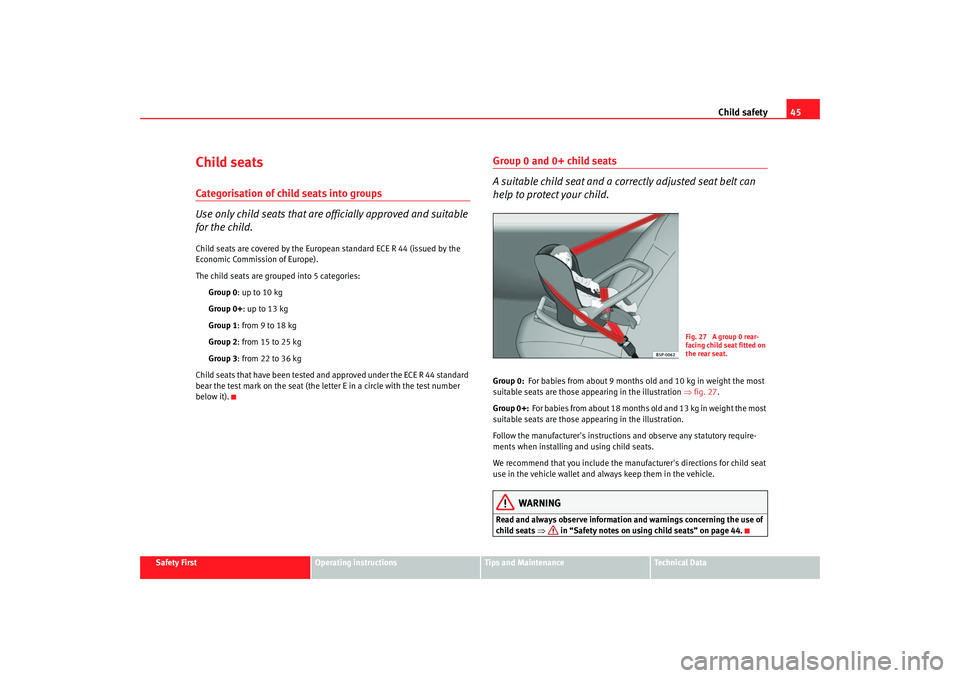
Child safety45
Safety First
Operating instructions
Tips and Maintenance
Te c h n i c a l D a t a
Child seatsCategorisation of child seats into groups
Use only child seats that are officially approved and suitable
for the child.Child seats are covered by the European standard ECE R 44 (issued by the
Economic Commission of Europe).
The child seats are grouped into 5 categories:
Group 0: up to 10 kg
Group 0+ : up to 13 kg
Group 1: from 9 to 18 kg
Group 2: from 15 to 25 kg
Group 3: from 22 to 36 kg
Child seats that have been tested and approved under the ECE R 44 standard
bear the test mark on the seat (the letter E in a circle with the test number
below it).
Group 0 and 0+ child seats
A suitable child seat and a corr ectly adjusted seat belt can
help to protect your child.Group 0: For babies from about 9 months old and 10 kg in weight the most
suitable seats are those appearing in the illustratio n ⇒ fig. 27.
Group 0+: For babies from about 18 months old and 13 kg in weight the most
suitable seats are those ap pearing in the illustration.
Follow the manufacturer's instructio ns and observe any statutory require-
ments when installing and using child seats.
We recommend that you include the manufacturer's directions for child seat
use in the vehicle wallet and always keep them in the vehicle.
WARNING
Read and always observe information and warnings concerning the use of
child seats ⇒ in “Safety notes on using child seats” on page 44.
Fig. 27 A group 0 rear-
facing child seat fitted on
the rear seat.
ibiza_ingles Seite 45 Mittwoch, 5. Oktober 2005 5:17 17
Page 48 of 252
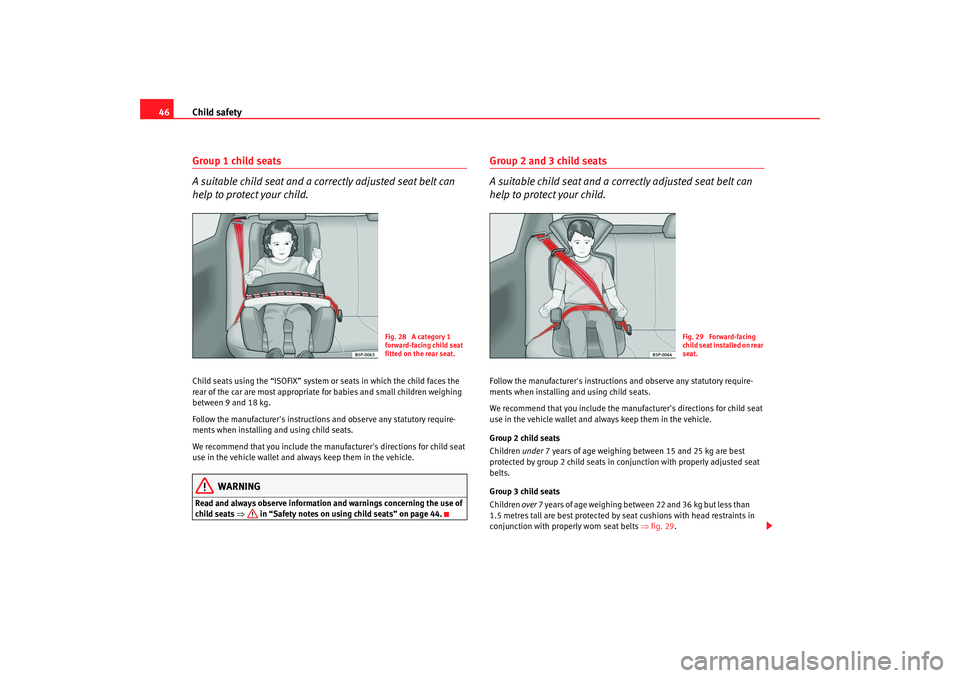
Child safety
46Group 1 child seats
A suitable child seat and a corr ectly adjusted seat belt can
help to protect your child.Child seats using the “ISOFIX” system or seats in which the child faces the
rear of the car are most appropriate for babies and small children weighing
between 9 and 18 kg.
Follow the manufacturer's instructions and observe any statutory require-
ments when installing and using child seats.
We recommend that you include the manufacturer's directions for child seat
use in the vehicle wallet and always keep them in the vehicle.
WARNING
Read and always observe information and warnings concerning the use of
child seats ⇒ in “Safety notes on using child seats” on page 44.
Group 2 and 3 child seats
A suitable child seat and a corr ectly adjusted seat belt can
help to protect your child.Follow the manufacturer's instructions and observe any statutory require-
ments when installing and using child seats.
We recommend that you include the manu facturer's directions for child seat
use in the vehicle wallet and always keep them in the vehicle.
Group 2 child seats
Children under 7 years of age weighing between 15 and 25 kg are best
protected by group 2 child seats in conjunction with properly adjusted seat
belts.
Group 3 child seats
Children over 7 years of age weighing between 22 and 36 kg but less than
1.5 metres tall are best protected by seat cushions with head restraints in
conjunction with properly worn seat belts ⇒fig. 29 .
Fig. 28 A category 1
forward-facing child seat
fitted on the rear seat.
Fig. 29 Forward-facing
child seat installed on rear
seat.
ibiza_ingles Seite 46 Mittwoch, 5. Oktober 2005 5:17 17
Page 49 of 252
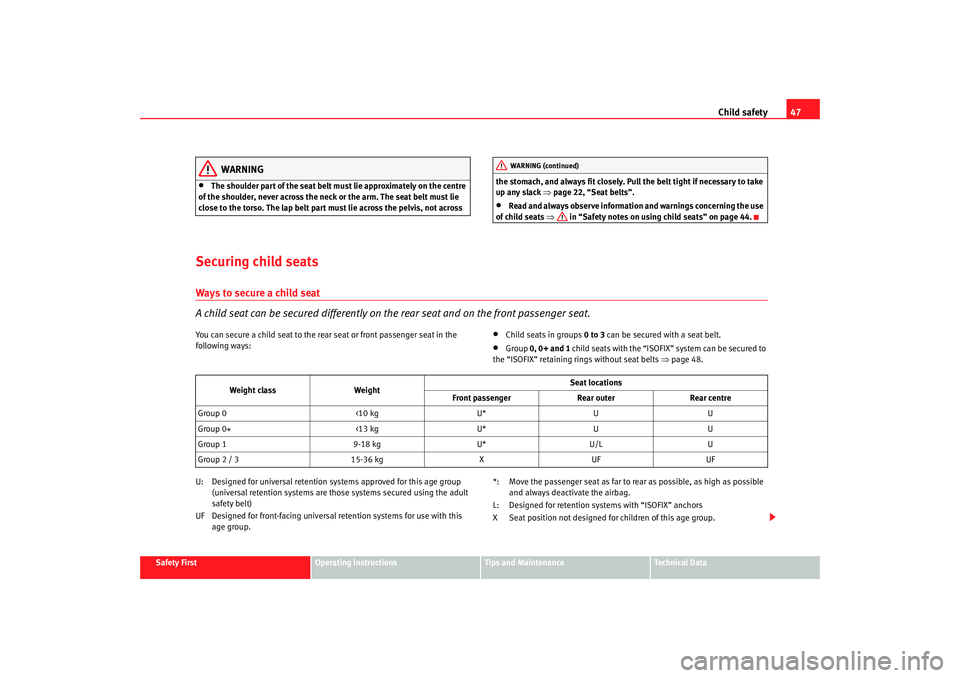
Child safety47
Safety First
Operating instructions
Tips and Maintenance
Te c h n i c a l D a t a
WARNING
•
The shoulder part of the seat belt mu st lie approximately on the centre
of the shoulder, never across the neck or the arm. The seat belt must lie
close to the torso. The lap belt part must lie across the pelvis, not across the stomach, and always fit closely. Pull the belt tight if necessary to take
up any slack ⇒
page 22, “Seat belts”.
•
Read and always observe information and warnings concerning the use
of child seats ⇒ in “Safety notes on using child seats” on page 44.
Securing child seatsWays to secure a child seat
A child seat can be secured differently on th e rear seat and on the front passenger seat.You can secure a child seat to the rear seat or front passenger seat in the
following ways:
•
Child seats in groups 0 to 3 can be secured with a seat belt.
•
Group 0, 0+ and 1 child seats with the “ISOFIX” system can be secured to
the “ISOFIX” retaining rings without seat belts ⇒ page 48.
U: Designed for universal retention systems approved for this age group (universal retention systems are those systems secured using the adult
safety belt)
UF Designed for front-facing universal retention systems for use with this age group. *: Move the passenger seat as far to rear as possible, as high as possible
and always deactivate the airbag.
L: Designed for retention systems with “ISOFIX” anchors
X Seat position not designed for children of this age group.WARNING (continued)
Weight class Weight Seat locations
Front passenger Rear outerRear centre
Group 0 <10 kgU*UU
Group 0+ <13 kgU*UU
Group 1 9-18 kgU*U/L U
Group 2 / 3 15-36 kgXUF UF
ibiza_ingles Seite 47 Mittwoch, 5. Oktober 2005 5:17 17
Page 50 of 252
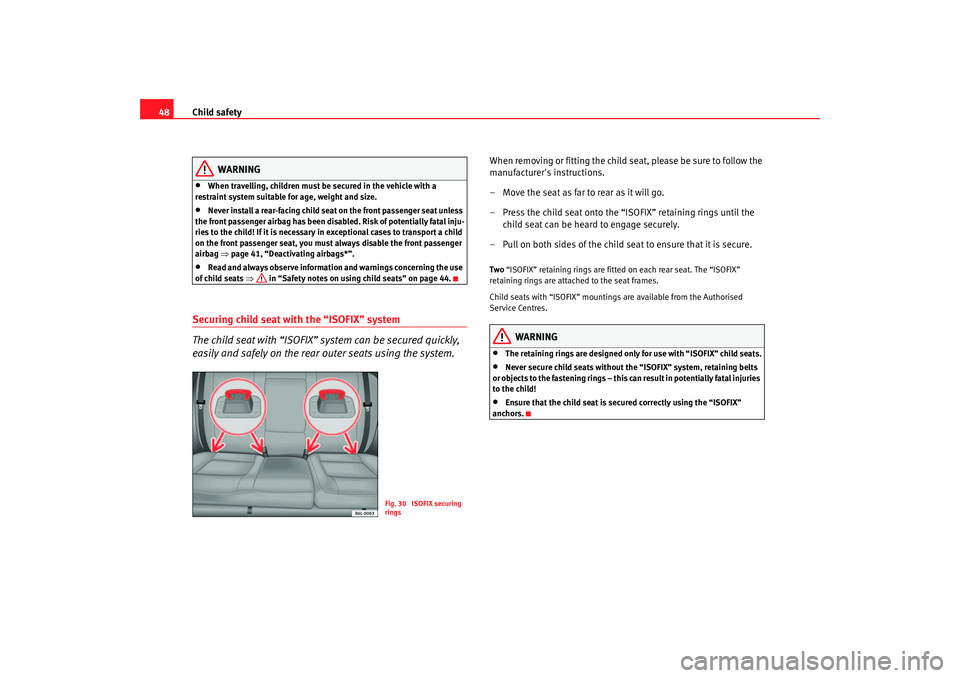
Child safety
48
WARNING
•
When travelling, children must be secured in the vehicle with a
restraint system suitable for age, weight and size.
•
Never install a rear-facing child seat on the front passenger seat unless
the front passenger airbag has been disabled. Risk of potentially fatal inju-
ries to the child! If it is necessary in exceptional cases to transport a child
on the front passenger seat, you must always disable the front passenger
airbag ⇒ page 41, “Deactivating airbags*”.
•
Read and always observe information and warnings concerning the use
of child seats ⇒ in “Safety notes on using child seats” on page 44.
Securing child seat with the “ISOFIX” system
The child seat with “ISOFIX” system can be secured quickly,
easily and safely on the rear outer seats using the system.
When removing or fitting the child seat, please be sure to follow the
manufacturer's instructions.
– Move the seat as far to rear as it will go.
– Press the child seat onto the “ISOFIX” retaining rings until the
child seat can be heard to engage securely.
– Pull on both sides of the child seat to ensure that it is secure.Two “ISOFIX” retaining rings are fitted on each rear seat. The “ISOFIX”
retaining rings are attached to the seat frames.
Child seats with “ISOFIX” mountings are available from the Authorised
Service Centres.
WARNING
•
The retaining rings are designed only for use with “ISOFIX” child seats.
•
Never secure child seats without the “ISOFIX” system, retaining belts
or objects to the fastening rings – this c an result in potentially fatal injuries
to the child!
•
Ensure that the child seat is se cured correctly using the “ISOFIX”
anchors.
Fig. 30 ISOFIX securing
rings
ibiza_ingles Seite 48 Mittwoch, 5. Oktober 2005 5:17 17
Page 63 of 252

Cockpit61
Safety First
Operating instructions
Tips and Maintenance
Te c h n i c a l D a t a
Item
Symbol Meaning of warning and control lamps Further information
Alternator fault ⇒page 62
Side/dipped lights ⇒page 62
Electro-hydraulic steering ⇒page 63
Engine fault (petrol engine) ⇒ page 63
Glow plug system (diesel engine)
Lit up: Glow plug system switched on
Flashing: engine fault.
⇒ page 63
Turn signals in operation ⇒page 63
Coolant level / coolant temperature ⇒page 64
Main beam switched on ⇒page 64
Fuel level / reserve ⇒page 64
Anti-lock brake system (ABS) * ⇒page 65
Parking brake applied
or low brake fluid level or
fault in brake system ⇒
page 65
Airbag or belt tension device system fault or airbag disabled ⇒page 26 ⇒page 29
Seat belt warning lamp* ⇒page 17
Fault in the emission control system ⇒page 66
A1A2A3A4A4A5A6A7A8A9A10A11A12A13
ibiza_ingles Seite 61 Mittwoch, 5. Oktober 2005 5:17 17
Page 102 of 252
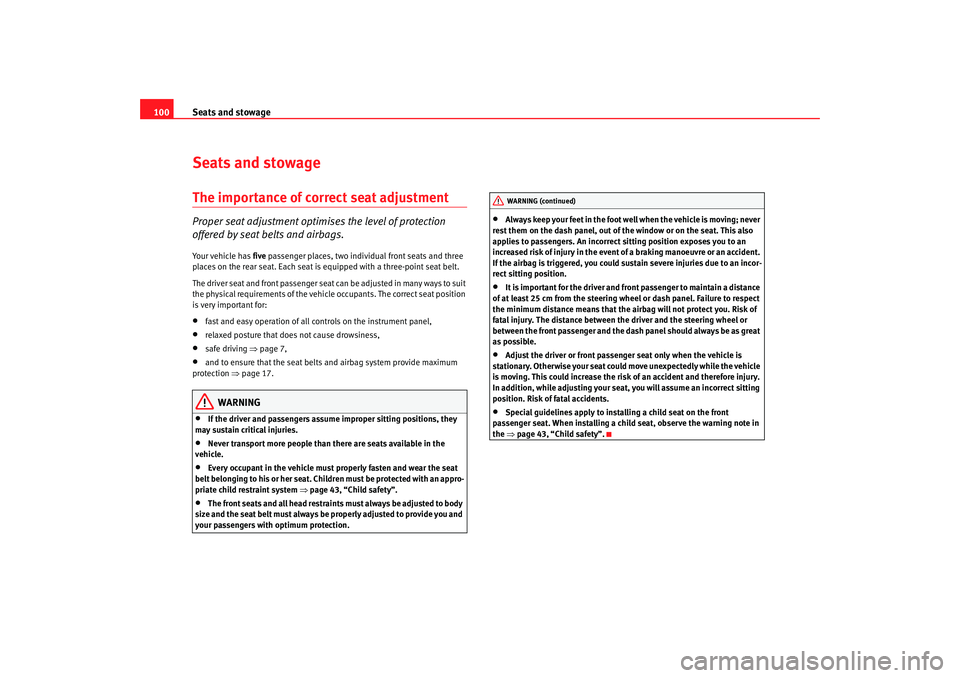
Seats and stowage
100Seats and stowageThe importance of correct seat adjustmentProper seat adjustment optimi ses the level of protection
offered by seat belts and airbags.Your vehicle has five passenger places, two individual front seats and three
places on the rear seat. Each seat is equipped with a three-point seat belt.
The driver seat and front passenger seat can be adjusted in many ways to suit
the physical requirements of the vehicl e occupants. The correct seat position
is very important for:•
fast and easy operation of all controls on the instrument panel,
•
relaxed posture that does not cause drowsiness,
•
safe driving ⇒page 7,
•
and to ensure that the seat belts and airbag system provide maximum
protection ⇒page 17.
WARNING
•
If the driver and passengers assume improper sitting positions, they
may sustain critical injuries.
•
Never transport more people than there are seats available in the
vehicle.
•
Every occupant in the vehicle must properly fasten and wear the seat
belt belonging to his or her seat. Children must be protected with an appro-
priate child restraint system ⇒page 43, “Child safety”.
•
The front seats and all head restraints must always be adjusted to body
size and the seat belt must always be properly adjusted to provide you and
your passengers with optimum protection.
•
Always keep your feet in the foot well when the vehicle is moving; never
rest them on the dash panel, out of the window or on the seat. This also
applies to passengers. An incorrect sitting position exposes you to an
increased risk of injury in the event of a braking manoeuvre or an accident.
If the airbag is triggered, you could sustain severe injuries due to an incor-
rect sitting position.
•
It is important for the driver and front passenger to maintain a distance
of at least 25 cm from the steering wh eel or dash panel. Failure to respect
the minimum distance means that the airbag will not protect you. Risk of
fatal injury. The distance between the driver and the steering wheel or
between the front passenger and the dash panel should always be as great
as possible.
•
Adjust the driver or front passenger seat only when the vehicle is
stationary. Otherwise your seat could move unexpectedly while the vehicle
is moving. This could increase the risk of an accident and therefore injury.
In addition, while adjusting your seat, you will assume an incorrect sitting
position. Risk of fatal accidents.
•
Special guidelines apply to installing a child seat on the front
passenger seat. When installing a chil d seat, observe the warning note in
the ⇒page 43, “Child safety”.WARNING (continued)
ibiza_ingles Seite 100 Mittwoch, 5. Oktober 2005 5:17 17
Page 103 of 252
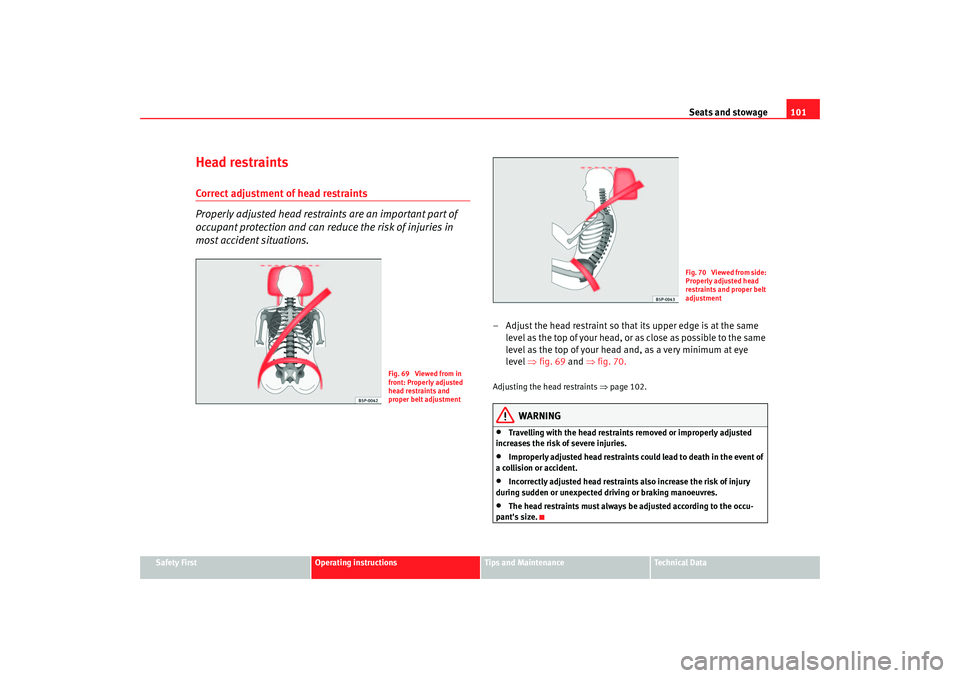
Seats and stowage101
Safety First
Operating instructions
Tips and Maintenance
Te c h n i c a l D a t a
Head restraintsCorrect adjustment of head restraints
Properly adjusted head restraints are an important part of
occupant protection and can redu ce the risk of injuries in
most accident situations.
– Adjust the head restraint so that its upper edge is at the same
level as the top of your head, or as close as possible to the same
level as the top of your head and, as a very minimum at eye
level ⇒ fig. 69 an d
⇒ fig. 70.
Adjusting the head restraints ⇒ page 102.
WARNING
•
Travelling with the head restrain ts removed or improperly adjusted
increases the risk of severe injuries.
•
Improperly adjusted head restraints could lead to death in the event of
a collision or accident.
•
Incorrectly adjusted head restraints also increase the risk of injury
during sudden or unexpected driving or braking manoeuvres.
•
The head restraints must always be adjusted according to the occu-
pant's size.
Fig. 69 Viewed from in
front: Properly adjusted
head restraints and
proper belt adjustment
Fig. 70 Viewed from side:
Properly adjusted head
restraints and proper belt
adjustment
ibiza_ingles Seite 101 Mittwoch, 5. Oktober 2005 5:17 17
Page 106 of 252
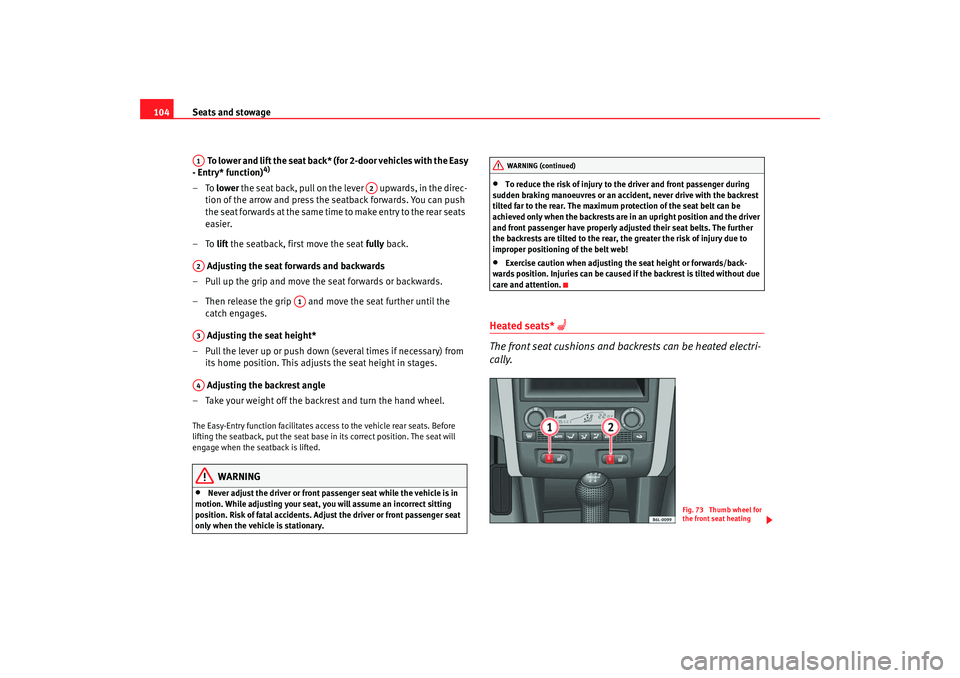
Seats and stowage
104
To lower and lift the seat back* (for 2-door vehicles with the Easy
- Entry* function)
4)
–To lower the seat back, pull on the lever upwards, in the direc-
tion of the arrow and press the seatback forwards. You can push
the seat forwards at the same time to make entry to the rear seats
easier.
–To lift the seatback, first move the seat fully back.
Adjusting the seat forwards and backwards
– Pull up the grip and move th e seat forwards or backwards.
– Then release the grip and move the seat further until the catch engages.
Adjusting the seat height*
– Pull the lever up or push down (s everal times if necessary) from
its home position. This adjusts the seat height in stages.
Adjusting the backrest angle
– Take your weight off the backrest and turn the hand wheel.The Easy-Entry function facilitates access to the vehicle rear seats. Before
lifting the seatback, put the seat base in its correct position. The seat will
engage when the seatback is lifted.
WARNING
•
Never adjust the driver or front passenger seat while the vehicle is in
motion. While adjusting your seat, you will assume an incorrect sitting
position. Risk of fatal accidents. Adju st the driver or front passenger seat
only when the vehicle is stationary.
•
To reduce the risk of injury to the driver and front passenger during
sudden braking manoeuvres or an acci dent, never drive with the backrest
tilted far to the rear. The maximum protection of the seat belt can be
achieved only when the backrests are in an upright position and the driver
and front passenger have properly adjusted their seat belts. The further
the backrests are tilted to the rear, the greater the risk of injury due to
improper positioning of the belt web!
•
Exercise caution when adjusting the seat height or forwards/back-
wards position. Injuries can be caused if the backrest is tilted without due
care and attention.
Heated seats*
The front seat cushions and backrests can be heated electri-
cally.
A1
A2
A2
A1
A3A4
WARNING (continued)
Fig. 73 Thumb wheel for
the front seat heating
ibiza_ingles Seite 104 Mittwoch, 5. Oktober 2005 5:17 17